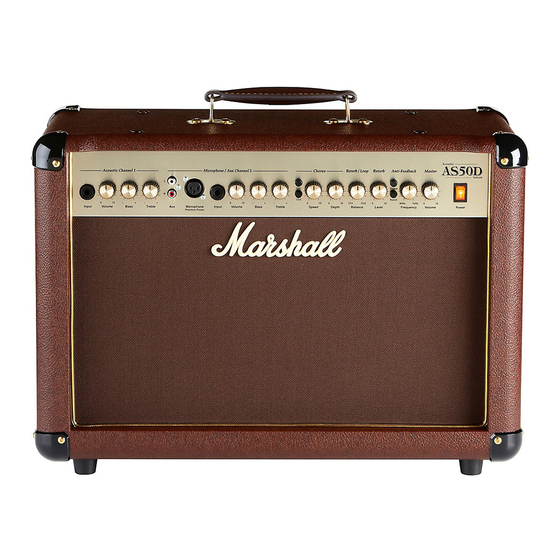
Marshall Amplification Acoustic Soloist AS50D Owner's Manual
50 watt combo amplifier
Hide thumbs
Also See for Acoustic Soloist AS50D:
- Product catalogue (32 pages) ,
- Owner's manual (4 pages)
Advertisement
Advertisement

Summary of Contents for Marshall Amplification Acoustic Soloist AS50D
-
Page 2: Front Panel Features
For clear and detailed performance, the AS50D is loaded with two 8" speakers and a high fidelity polymer dome tweeter. There is also an internal limiter which allows you to push the maximum level from the 50 Watt output, whilst remaining distortion free. -
Page 3: Rear Panel Features
Before connecting for the first time, please ensure that your amplifier is compatible with your electricity supply. If you have any doubts, please get advice from a qualified person. Your Marshall dealer can help you in this respect. 2. Footswitch Jack... -
Page 4: Front/Rear Panel View
AS50D Front Panel Acoustic Channel 1 Acoustic Channel 1 Input Volume Bass Treble AS50D Rear Panel AS50D Block Diagram BASS TREBLE INSTRUMENT TAPE IN BASS TREBLE Microphone / Aux Channel 2 Microphone / Aux Channel 2 Chorus Chorus Microphone Input...














Need help?
Do you have a question about the Acoustic Soloist AS50D and is the answer not in the manual?
Questions and answers
Microphone cable/connector for Shure SM58. XLR vs Jack input? So I've recently bought the AS50D amp for my acoustic guitars but intend to use it also for a microphone at pub gigs. I have, kicking around from a bundle I bought years ago, a Shure SM58 mic which has an XLR connection, but came with a lead terminating with a 6.3mm Jack. It works fine, but I'm a complete newbie to the subject and all I can tell is that it makes the voice louder (yes, that's about my level of knowledge). Simple question really, appreciate a simple answer (cos I won't understand the technical jargon): Given that the mic channel on ths amp has both input types, will there be any difference if I get an XLR lead compared with the Jack? Other answers I've found talk about low or high impedance, making an assumption that a guitar amp will be low, but I really don't know what that means in the context of this amp, so that would also be useful to know. Thanks
The main difference is the input impedance and compatibility:
- Using an XLR cable, you connect the Shure SM58 to the Microphone input, which has an input impedance of 1kΩ and is designed for microphones. This is the correct and optimal method.
- Using a 6.3mm Jack cable, you would connect to the Guitar/Line input, which has an input impedance of 1MΩ, meant for guitars or line-level sources. This is not ideal for a dynamic microphone like the SM58.
Therefore, use an XLR cable for proper performance and sound quality.
This answer is automatically generated
@Mr. Anderson There's also a jack input for the microphone channel, so my choice is between the Jack and the XLR both on the microphone channel. From what I've read the XLR input does something different with some sorts of microphone, but I don't understand exactly what, and whether this mic would benefit.
Does using the line out, switch of the speakers. ie if I go from the line out to a mixer and use headphones from the mixer will the sound not come out of the speakers on the amp. ( As50d )
No, using the Line Out on the Marshall Acoustic Soloist AS50D does not mute the speakers when connected to a mixer. The Line Out and DI Out provide a constant level signal while the internal speakers continue to operate.
This answer is automatically generated